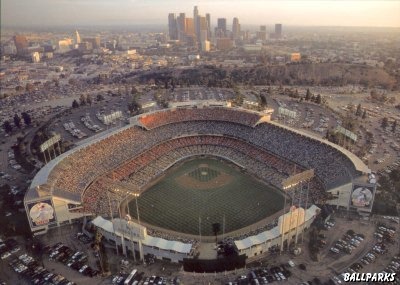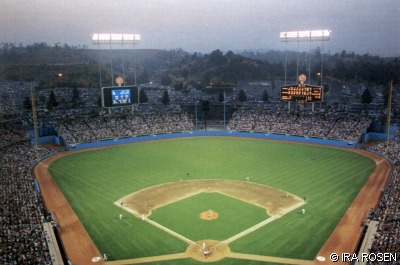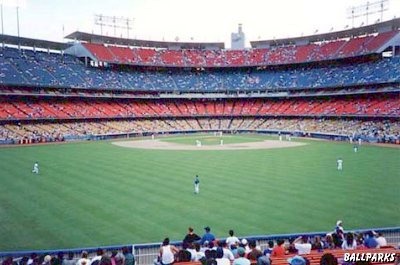Dodger Stadium
A.K.A. Chavez Ravine
Los Angeles, California
Tenants: L.A. Dodgers (NL; 1962-present); L.A. / California Angels (AL; 1962-1965)
Opened: April 10, 1962
Surface: Santa Ana Bermuda grass
Capacity: 56,000
Parking: 16,000 cars
Architect: Captain Emil Praeger
Builder: Vinell Construction Company
Owner: Los Angeles Dodgers
Land area: 300 acres
Cost: $23 million
Los Angeles Dodgers tickets:
Location: In Chavez Ravine, on a hill overlooking downtown Los Angeles. Left field (N by NW), Glendale Boulevard; third base (W by SW), Sunset Boulevard; home plate (S by SW), 1000 Elysian Park Avenue; first base (S by SE), Pasadena Freeway (I-10); right field (E by NE), Los Angeles Police Academy, Elysian Park, and Golden State Freeway (I-5); Stadium Way encircles the park.
Dimensions: Foul lines: 330; power alleys: 380 (1962), 370 (1969), 385 (1983); center field: 410 (1962), 400 (1969), 395 (current); backstop: 65 (1962), 68.19 (1963), 75 (1969); foul territory: large.
Fences: Left-center to right-center: 10 (wood 1962), 8 (1973); foul poles to bullpens in left- and right-field corners: 3.75 (steel 1962), 3.83 (1969); "The Dip" (where low corner steel wall and screen bullpen fence meet): 3.42 (1962), 3.5 (1969).
When Dodgers owner Walter O’Malley was negotiating with the city of Los Angeles in 1957 over the deal that would take the Dodgers out of Brooklyn, he and a county supervisor took a helicopter ride over Los Angeles to look for potential stadium sites. When they flew over the undeveloped 300-acre lot at Chavez Ravine, surrounded by freeways and within sight of the downtown skyline, O’Malley is said to have pointed and asked, "Can I have that one?" The supervisor replied, "No problem."
Dodger Stadium was baseball’s only privately financed stadium built since Yankee Stadium (1923) and until Pacific Bell Park (2000). Until Denver’s Coors Field was built in 1995, Dodger Stadium and Chicago’s Wrigley Field were the only National League parks built exclusively for baseball. The Los Angeles / California Angels shared Dodger Stadium from April 17, 1962 until September 22, 1965. The stadium was known as Chavez Ravine when the Angels were playing there.
Dodger Stadium Trivia:
- A classic pitcher’s park.
- No drinking-water fountains when first built.
- Original design had a huge fountain in center field, like that in right-center at Kansas City’s Kauffman Stadium.
- Designed by architect Emil Praeger to be expandable to 85,000 seats.
- When foul poles were installed in 1962, it was discovered that they were positioned completely foul. A special dispensation was received from the National League so that they were recognized as fair, but the next year the plate was moved so that the poles are now actually fair.
- Painted every off-season.
- Infield dirt and outfield warning track made of 70 percent crushed red building brick and 30 percent mountain clay and calcium chlorate.
- Palm trees beyond the fence down the foul lines.
- See-through windows in bullpen fence installed in 1974.
- Although the center field 400 sign came down in 1980, the distance is still 400 feet to center; the two 395 signs are left and right of dead center.
- Cleanest ballpark in MLB.
- Hosted the 1980 All-Star game.
More on Dodger Stadium:
Recommended Reading (bibliography):
- Dodger Stadium by Mark Langill.
- The Dodgers Move West by Neil J. Sullivan.
- Chavez Ravine, 1949: A Los Angeles Story by Don Normark.
- Fodor's Baseball Vacations, 3rd Edition: Great Family Trips to Minor League and Classic Major League Ballparks Across America by Bruce Adams and Margaret Engel.
- The Ultimate Baseball Road-Trip: A Fan's Guide to Major League Stadiums by Joshua Pahigian and Kevin O'Connell.
- Joe Mock's Ballpark Guide by Joe Mock.
- Take Me Out to the Ballpark: An Illustrated Tour of Baseball Parks Past and Present by Josh Leventhal and Jessica Macmurray.
- The Ballpark Book: A Journey Through the Fields of Baseball Magic (Revised Edition) by Ron Smith and Kevin Belford.
- Ballparks: A Panoramic History by Marc Sandalow and Jim Sutton.
- Field of Schemes: How the Great Stadium Swindle Turns Public Money into Private Profit (2nd Edition) by Joanna Cagan and Neil deMause.
- Public Dollars, Private Stadiums: The Battle over Building Sports Stadiums by Kevin J. Delaney and Rick Eckstein.
- Sports, Jobs, and Taxes: The Economic Impact of Sports Teams and Stadiums by Roger G. Noll and Andrew Zimbalist.
Los Angeles Dodgers
Dodger Stadium
1000 Elysian Park Avenue
Los Angeles, California 90012
Help us provide a better web site by completing our feedback form
PHOTOGRAPHS:
Aerial view of Dodger Stadium © 1999 by Mike Smith.
View inside Dodger Stadium © 1999 by Ira Rosen.
View of Dodger Stadium from the outfield courtesy of Kevin Marsh.
Updated August 2005
Tickets to Los Angeles Dodgers, Dodgers Angels, Dodgers Giants, NCAA Basketball Tournament, College Football Bowl, NCAA Football, Paul McCartney and Wicked Hollywood provided by Ticket Triangle.
BALLPARKS © 1996-2014 by Munsey & Suppes.
|









